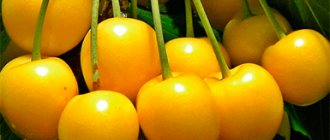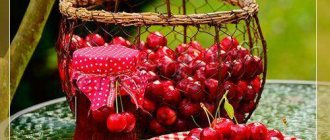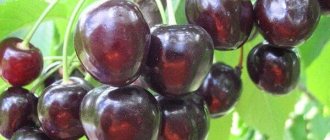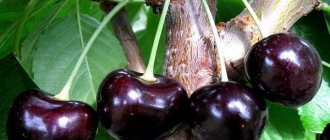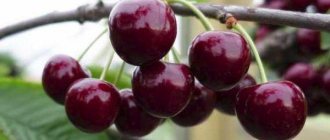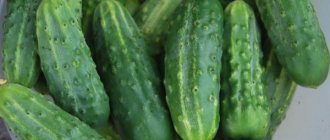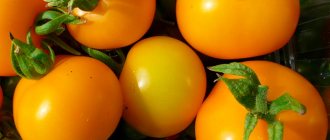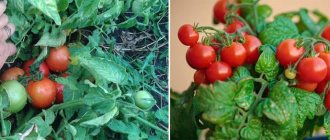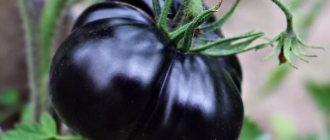Photo and description
The description of the Raditsa variety allows us to highlight the characteristic features inherent in this particular cherry and making it possible to distinguish it from other similar varieties.
general description
The variety is mid-season, very productive. The tree grows rapidly, quickly gains height and reaches 4 m in height. The crown is oval, not very thick, well leafy. The fruits are red, tasty, with excellent commercial characteristics.
Bud
The cherry bud is of a generative type, large in size, and shaped like a cone. She is strongly discouraged from escaping.
Leaf and flower
Raditsa's leaf has an obovate shape and is slightly elongated. Its color is bright green, jagged edges are clearly visible, and the base is rounded. The inflorescence contains 3 separate flowers with snow-white petals. The anthers and stigma of the pistil are at the same level, the calyx is goblet-shaped.
Fetus
The Raditsa cherry is famous for its fruits, for which both amateurs and professionals plant it in their gardens.
Weight
Depending on the growing conditions, the weight of the Raditsa fruit is 4.6-5.7 g.
Height
The height of the cherry fruit is 2.5-3 cm.
Width
The width of the Raditz berry reaches 2.5-2.8 cm.
Thickness
Of the total volume of cherries, the pit accounts for only 5.2%, which is why the berry is fleshy, with a thick layer of pulp.
Color
When ripe, the flesh of the fruit acquires a dark scarlet color, and the skin becomes red-black.
peduncle
Raditsa's peduncle is small, pigmented, and divided into 3 glands.
Bone
The seed is small, beige in color, and occupies a little more than 5% of the total volume of the fruit.
Sweet cherries: varieties suitable for the Moscow region
Varieties and varieties of cherries for growing in the central regions of Russia
Sweet cherry and sour cherry are close relatives, but the cherry tree is distinguished by its tall growth, sweeter berries, and traditional cultivation in southern regions. Breeders from the central regions of Russia have developed a number of cherry varieties adapted to the harsh conditions of Russian winters; as a result, the following varieties were recommended for gardens in the Moscow region:
- “Iput” is a delicious cherry with a fruit weight of up to 9 g, dark ruby color, with juicy and sweet pulp. The cherry tree is medium in height and has a pyramidal crown. The variety is resistant to winter frosts and characteristic cherry infections.
Advice! Among the cherries there are self-fertile and self-sterile varieties. To ensure a high yield, it is worth planting trees of both groups when forming a garden.
Proper planting of cherries in the central regions of Russia, including the Moscow region
For a cherry orchard, you should choose places protected from the wind with good lighting. Trees do not tolerate winter cold well, so it is necessary to choose zoned varieties with good winter hardiness. In ventilated gardens, it is useful to install protective screens painted white - this is the easiest way to provide plants with more comfortable conditions.
general characteristics
Raditsa is a mid-season, high-yielding variety with fruits of universal use. The harvest is distinguished not only by high taste, but also by commercial characteristics. Cherries contain:
- sugar - 11.2%;
- acid - 0.4%;
- dry matter - 16.1%.
For every 100 g of product there is approximately 13.5 mg of ascorbic acid. The fruits are not prone to cracking.
Taste qualities
The cherries taste sweet; tasters rated their quality at 4.5 points.
Nutrient content
Cherry fruits contain a large number of useful substances:
- vitamin C;
- thiamine;
- vitamin A;
- B vitamins;
- calcium;
- iron;
- phosphorus;
- zinc;
- potassium;
- beta-carotene.
Tree height and growth rate
Raditsa grows quickly and rapidly. The maximum height of an adult tree reaches 4 m.
Flowering and ripening period
Cherries begin to bear fruit 4 years after the seedling is planted in the garden. Fruit ripening occurs simultaneously. Flowering begins in the first half of May, and the harvest ripens by mid-June.
Productivity
Raditsa is considered a high-yielding variety, yielding about 60 centners of ripe cherries from each hectare of plantings.
Transportability
The medium-density pulp provides the fruit with good transportability.
Drought resistance
The variety is not considered drought-resistant and requires regular watering. At the same time, the tree does not tolerate stagnant moisture.
Frost resistance
Raditsa cherry is a frost-resistant variety that can withstand winter temperatures down to -29 °C. If this indicator is exceeded, the tree freezes by 1.5 points. In the event of spring return frosts, the yield is reduced by 56%.
Resistance to coccomycosis, moniliosis, clasterosporiasis
Raditsa has increased resistance to coccomycosis and moniliosis, as well as average immunity to klyasterosporiosis.
Application of fruits
Cherries are suitable for fresh consumption, as well as various types of processing:
- preparing tincture;
- making homemade wine;
- preparation of compotes;
- making jam;
- making jam;
- making jelly;
- conservation;
- freezing;
- drying.
Basic soil requirements
Raditsa cherry prefers light, fertile loamy or sandy loam soil with good air permeability for planting. This variety cannot be planted in areas where clay, sand or peat predominate. The groundwater level should not approach the surface more than 2 m.
Preferred climate
Raditsa is excellent for cultivation in temperate climates. The tree also feels good in the gardens of the Moscow region.
Cherry Raditsa
This excellent variety has high yields.
Raditsa cherry is a fairly heat-loving fruit tree, demanding on climate and soil quality. For this variety, snowless winters are difficult and can freeze and die. However, all the difficulties in growing and caring for these cherries are easily compensated by the rich yield of beautiful and tasty berries.
From the history of selection
Raditsa cherry was obtained by the breeder Kanshina through crossing the varieties “Kommunarka” and “Leningradskaya Chernaya” at the All-Russian Scientific Research Institute named after Lupin. The variety was included in the state register in 2001. Recommended area for cultivation is the Central region.
Cherry Raditsa: description of the variety and characteristics
Cherry Raditsa: photo of the variety
The Raditsa cherry variety is distinguished by its rapid growth, dense foliage, medium height and moderately dense round crown.
- The buds are large, vegetative, cone-shaped, deflected at a good angle, generative.
- The leaf of the Raditsa cherry is obovate, elongated, pointed, small, bright green, the base of the leaf is rounded. Small pigmented petioles - with two or three glands.
- Each inflorescence has 3 flowers. Each snow-white petal seems to follow another. The stigmas of the pistils are located at the same height as the anthers. The length of stamens and pistils is above average.
- More than half of the berries ripen on the bouquet branch.
- The weight of the fruit is average (4.5-5.7 grams), the shape is oval, the color is rich burgundy (closer to black). The fruit has a voluminous funnel and a rounded apex, with moderate density. The fruit has dark red flesh and a beige, easily separated seed.
- The berries of the Raditsa variety are quite sweet (more than 11 percent). The content of ascorbic acids per 100 grams of berries is about 13.5 mg.
The taste of the variety is high, ripe Raditsa cherries do not crack.
Next, let's talk about the characteristics of the Raditsa cherry variety: drought resistance, winter hardiness, flowering period and ripening time, etc.
The variety in question is quite attractive for both professional and amateur gardeners. The Raditsa seedling grows quickly, reaching a height of up to 4 meters. The frost resistance tests carried out showed that adult plants froze by only 1.5 points at sub-zero temperatures down to -34°C.
About drought resistance and frost resistance of Raditsa cherries
Raditz cherries are not considered drought-resistant. It requires regular watering, but at the same time does not tolerate stagnant moisture. If excess water is present, the fruit will crack as it ripens.
Watering is especially important for young plants - at least twice every 7 days. On the eve of winter, Raditz requires moisture-charging replenishment. For adult plants, repeated watering is required throughout the entire growing season, in the autumn – once every 7 days.
The frost resistance of Raditsa cherries is moderate. In a snowy winter at low temperatures, Raditsa feels more comfortable than in a harsh winter with little snow (protection of young plants is mandatory).
About pollination, flowering period and ripening time
For the self-sterile “Raditsa”, “Revna”, “Tyutchevka” or “Iput” can be used as the best pollinators. It should be taken into account that this cherry blossoms at the beginning of the last spring month, and we can talk about the ripening of the fruits in the 20th of June.
How to choose a seedling
A real Raditz seedling should have a noticeable grafting site, which indicates that the plant is truly a varietal plant. The cherry tree chosen for planting has a main trunk thickness of about 17 cm.
Preference should be given to a seedling 1-2 years old, which has at least 3-4 branches about 0.4 m long. A tree with two trunks can easily break under the weight of the harvest. The root system should not be too dry. Cherries are selected without mechanical damage, broken shoots or signs of disease.
See also
Description of the Bryanochka cherry variety, planting and care, pollinatorsRead
Harvest and storage
The Donchanka cherry begins to bear fruit at the age of four. The berries ripen in early June - mid-July. Several days are allotted for harvesting, since ripe fruits quickly fall off and rot.
The Donchanka cherry variety is distinguished by its annual high yield
About 50 kg of berries are harvested from a tree less than 10 years old, and up to 100 kg from a tree older than 10 years. The fruits are removed manually using stands and ladders.
For storage, the berries are carefully sorted. If there is any moisture left on them, they must be dried. Selected fruits are placed in the refrigerator in a plastic, glass or ceramic container, covered with a napkin or lid. You cannot wash cherries after picking. At room temperature, the fruits are stored for 3-4 hours, in the refrigerator - up to 2 days.
For transportation, the berries are collected with the stalk - this extends the shelf life by 1-2 days. However, picking the fruits in a “bundle” is not recommended, as this harms the tree and affects the number of ovaries in the future. The berries are placed in spacious shallow boxes, covering the bottom with paper and the berries with cotton cloth (to prevent drying out).
Donchanka fruits are universal. They are consumed fresh, and also used for making compote, preserves, confiture, jam, etc.
You can prepare any preparations for the winter from the fruits of this variety.
Planting dates and scheme
Raditsa cherry trees are planned to be planted in the spring. The work is carried out before the buds begin to bloom on the seedlings, that is, almost immediately after the snow begins to melt. The distance between neighboring fruit trees or shrubs and planted cherries is left about 4 m.
Before planting, the cherry roots are dipped in a root formation stimulator for 10 hours, after which the damaged roots are carefully trimmed. A wooden peg is driven into the prepared planting hole, the tree is installed and the root system is carefully straightened, after which the hole is filled with earth. The root collar must protrude 4 cm above the soil surface.
Pit preparation
They begin to prepare a planting hole for cherries in the fall. During this period, the necessary fertilizers, in particular superphosphate, are applied so that they have time to dissolve before spring.
It is recommended to add a little lime or dolomite flour to acidic soil, and then dig up the area. After 14 days, dig a hole about 0.8 m wide and at least 0.5 m deep. A couple of buckets of compost or humus are added to the top fertile layer of soil, and in the spring another 1 kg of wood ash is added. From the resulting mixture a tubercle is formed at the bottom of the planting hole.
You should not be too zealous with fertilizers so that the cherries do not produce excessive growth of branches, which will not have time to ripen during the season and will die in the winter.
Features of planting a tree
Cherries are planted in the southern regions in the fall. In warm areas, the seedling has time to develop a root system before the arrival of cold weather. If we are talking about the middle or northern zone, it is better to plant the crop in the spring, in early March, before the sap flows. Then the cherries will be protected from frost, the rhizome will have time to form before the next season
It is important that the air temperature is stable from 10 degrees Celsius, there are no night frosts
Selection of seedlings
It is better to purchase cherries in the fall, then there is more choice of planting material. Make purchases from nurseries or professional breeders. Purchasing a seedling on the market from unverified sellers risks getting a wild tree or the wrong variety. The seedling must be one year old, consist of 5-6 branches, one conductor.
Pre-inspect the seedlings for integrity, absence of damage, healthy rhizomes. There should be no damaged areas or dried out areas. There must be a grafting site on the plant. When transporting, wrap the cherries in a wet cloth and wrap cling film on top.
Site preparation
3 weeks before planting, the plot should be prepared. It is necessary to add mineral fertilizers to the soil and mix them with the soil. Weed the soil, it should be saturated with oxygen.
Pit preparation
2 weeks before the planned planting, they dig a hole 0.6-0.7 meters deep. 3-5 buckets of water are poured into it, fertilizers such as manure or compost are added. In 14 days, the soil will settle and the plant will take root better.
Planting a tree
In order for seedlings to grow and develop quickly, you should adhere to the following planting rules.
- In a pre-dug hole, separate the top layer of soil from the bottom.
- Drive a 1.5 meter high stick into the center.
- Combine the top layer of soil with a combination of fertilizers - 7-8 kg of compost, 180-200 g of superphosphate, 60-80 g of potassium sulfate, 450-500 g of wood ash. Form a mound around the installed support.
- Dip the rhizome of a young tree in a clay mash, straighten it, place it in a recess on the formed mound next to a stick.
- Sprinkle the root system with soil, compact it tightly layer by layer so that there are no gaps.
- Tie the seedling with twine to a figure eight peg.
- The distance from the surface of the earth to the rhizome after planting should be 4-5 centimeters.
- Form a hole along the tree trunk with a diameter of 50-60 cm.
- Water the tree with 2-3 buckets of water, mulch with sawdust in a layer of 5-7 cm.
The root collar of the plant should be flush with the ground surface.
Care
To obtain a high-quality and abundant harvest, Raditsa cherries require proper care and compliance with agrotechnical conditions.
Feeding and watering
Sweet cherries need fertilizing only 2 years after planting. Until this period, it has enough nutrients and fertilizers that were added to the soil during planting. At the beginning of spring, nitrogen is applied to the tree, and with the beginning of autumn, they begin to prepare it for wintering. For this purpose, superphosphate is incorporated into the soil.
To ensure good yield, Raditsa is fed with green fertilizers. Lupine, vetch or sainfoin are best suited for these purposes. They are sown in the circle of cherry trees at the beginning of summer. It is advisable to plant nearby vegetation that attracts bees for pollination. With the onset of autumn, the entire green cover is mowed down and embedded in the soil to rot and obtain fertilizer.
Raditsa cherry is not a drought-resistant crop and therefore requires regular watering. The seedlings are watered a couple of times a month. Before the onset of cold weather, the soil in the circle around the trunk is thoroughly watered again so that the root system does not freeze.
An adult tree is irrigated 4 times during the growing season. In autumn, the tree needs weekly watering. If flowering occurs during a dry period, more moisture will be required.
Weeding and loosening
Immediately after planting, weeds are regularly removed around the cherry tree. After each watering or heavy rainfall, it is necessary to loosen the soil and renew the layer of mulch.
Crown formation
When forming the crown of the Raditz cherry, it is taken into account that the trunk should rise 20 cm above the skeletal branches. With the onset of spring, all annual shoots are removed. There should be 3 skeletal branches in the lower tier. At a height of 0.7 m from it, the next tier is formed from 3 more shoots. When the cherry tree reaches an age of more than 5 years, it will only need sanitary pruning, which involves removing frozen or damaged shoots.
Pollinators
Raditsa is a self-sterile variety and requires mandatory planting of pollinators nearby. Therefore, experienced gardeners advise planting several more varieties nearby:
- Revna;
- Tyutchevka;
- Here we go.
It is also possible to plant early-blooming cherries near Raditsa, which can also serve as pollinators.
Cherry Raditsa
The cherry variety was bred by crossing the Kommunarka and Leningradskaya Chernaya varieties at the All-Russian Research Institute of Lupina Michurinsky by the famous breeder M. V. Kanshina. It was included in the State Register of Breeding Achievements of Russia back in 2001. It is recommended to plant it in the Central region.
Photo and description of the Raditsa cherry variety
The crown is spherical and has medium foliage density. Vegetative and generative (flower) buds are large, in the form of cones. The foliage is obovate, has sharp edges at the top and a rounded base. The border of cherry leaves is in the form of cloves of various sizes. The inflorescence consists of 3 snow-white flowers.
The berry weighs 4.6-5.7 g and is considered medium in size. The fruit is oval-shaped, has a wide funnel and a rounded top. The cover color is dark burgundy, closer to black. The pulp is dark scarlet, medium in density. Beige cherry pit - 5.2% of the weight of the berry. It is easily separated from the pulp. Cherries are sweet, since they contain 11.2% sugars, the acid is invisible - 0.4%. 100 g of fruit contains approximately 13.5 mg of ascorbic acid. The fruits contain 16.1% dry matter. The taste is excellent, it is rated 4.5 points. The berries do not crack.
The fruits are consumed fresh, made into tinctures, wine, compotes, jams, jams, jelly, canned, frozen and dried.
Mature tree height
The tree grows intensively, reaching a height of 4 meters.
Flowering and ripening period
Cherries are removed from the tree 4 years after planting. The berries ripen at the same time.
Productivity
The variety is high-yielding. An average of 60 centners of cherries are harvested from 1 hectare of cherries.
Transportability
The pulp is medium dense, so the berry is transportable.
Drought resistance
Cherry is not drought-resistant. Loves watering, but does not tolerate stagnant water.
Frost resistance
In tests at winter air temperatures of -29-34°C, the cherries froze by 1.5 points, and the generative buds were 42%. Return frosts in the spring (-3-5°) killed 56% of the pistils.
How to plant Raditz cherries
The best places for Raditsa cherries are gentle slopes in the south or southwest of the site. You can also plant it south of the house. The tree loves good lighting. The soil required is fertile, light, loose, sandy loam or loamy soil is suitable. You cannot plant trees in clay, peat, or sand. An area where groundwater is less than 2 meters away is not suitable, because the root system rots.
How to choose a seedling
It is necessary to make sure that the seedling has a grafting site. This means that the cherries are varietal. A smooth trunk should have a diameter of 17 cm. A healthy two-year-old tree has at least 3-4 branches, each 40 cm long. If the cherry tree has 2 trunks, then the tree can break under the weight of the berries and die. The roots should not be dry. Before planting, the leaves are torn off so that the nutrients are consumed correctly.
Planting dates and scheme
Planting holes are prepared in the fall. Seedlings are placed in the soil in early spring, as soon as the snow melts, but the buds have not yet burst.
Pit preparation
If the soil is acidic, then sprinkle lime or dolomite flour and dig up the ground. After 2 weeks, planting holes are dug at a distance of 3 m; they should be 0.8 m wide and 0.5 m deep. Mix 1-2 buckets of humus or compost with the top layer of soil. In spring, add 1 kg of ash. The mixture is then formed into a cone at the bottom of the pit. Fertilizers are applied in moderation. Due to the excess, there is intensive growth of branches, which do not have time to grow stronger by autumn and die in winter.
Before planting, the roots of the seedlings should be placed in the Kornevin solution for 6-10 hours. Then the seedling is inspected, damaged ones are cut off and all roots are trimmed. A stake is driven into the hole. Place the seedling on an earthen cone to the south of the driven stake. Straighten the roots so that they do not curl up, sprinkle the seedling with soil.
The root collar must not be in the ground, otherwise the tree will die. When planting, raise the tree so that the root collar rises 4-5 cm above the surface. They tie the trunk to the stake, making a figure eight out of the tape so that the trunk is not damaged when it grows.
A hole is made near the trunk, and a roll of soil is poured around the circumference. Pour 2 buckets of water under each cherry. Then add peat or humus mulch.
Cherry care Raditsa
In order for cherries to please with their fertility and appearance, proper care during and after planting is important.
Feeding and watering
Feed only for 2 years. Until this time, the plants have enough substances added to the planting hole. In April or May, the crop is fertilized with nitrogen. In mid-September, cherries are prepared for winter. To do this, pour up to 60 g of superphosphate per 1 m² under the tree trunk. Fertilizer is dug in to penetrate the root system.
For a good harvest, cherries are fed with green fertilizer. They are lupine, sainfoin and vetch, which are planted in the tree trunk from mid-June. Plants that attract bees are also sown - phacelia, mustard. And in the fall, the plants are mowed and buried in the soil. They rot over the winter, forming compost that feeds the crop.
Raditsa cherry does not tolerate lack of moisture. Young trees especially need watering - 2 times a month. Be sure to carry out pre-winter moisture replenishment.
Mature trees are watered 4 times during the growing season, and once a week in the fall. Moisturizing is required more often if the cherry blossomed during a drought. It is important to be careful, because due to excess water during the ripening period, the berries will burst. Therefore, watering stops from July 20 and in August.
Weeding and loosening
During the year of planting, weeds are constantly pulled out. A year later, a tree trunk circle is made at a distance of 1 m from the trunk and the vegetation is pulled out. Then it is expanded annually, adding 50 cm. Also, after each watering, the soil is loosened shallowly or mulch of peat and humus is added.
Crown formation
Cherry trees are pruned in the spring, removing branches that are 1 year old. The trunk should rise 20 cm above the skeletal branches. If you planted a two-year-old seedling, you should leave 4 strong branches on it. They shorten before the buds burst. If this time is missed, then the cherry tree is pruned the next season.
When forming the crown, 3 skeletal branches are left in the lower tier. Two of them are at the same height, and the third branch is 20 cm higher. After 70 cm, a second tier with three branches is formed: two at the same level, the third 30 cm higher. The angle between the trunk and shoots is 45-50°. Wounds that appear after pruning are lubricated with garden varnish to prevent gum from appearing.
Until the tree reaches the age of 5 years, annual growth is shortened by 1/5 annually. For cherries that are older than 5 years, branches that are directed into the crown, broken, dried out, or diseased, are cut off.
Pollinators of the Raditz cherry
The Raditsa cherry is self-sterile. Therefore, it is recommended to plant 1 or 2 more varieties: Revna, Iput, Tyutchevka. It’s great if cherries are planted in your dacha, which also bloom early, as they will be able to pollinate the cherries.
Diseases and pests of Raditsa cherries
Measures against pests:
- For aphids, spray with Confidor until the buds swell, and then after 14 days. Also, to eliminate parasites, make a solution from tobacco dust by pouring 200 g into a bucket of water. Soap is added to the composition to adhere to the leaves.
- To prevent cherry flies, when the buds begin to bloom, yellowish sticky traps made of plywood or plastic are placed on the tree.
- From winter moths, before the buds begin to swell, plants are sprayed with Nitrafen, and before flowering, the crop is treated with a solution of karbofos or phosphamide.
- To prevent bird attacks, a net is pulled over the cherries when tying berries.
Processing Raditsa cherries in spring
In the spring, the trunk and part of the main branches are whitened with a solution of lime and clay. Also, to prevent parasites in the spring, cherries are sprayed with Inta-vir and also with urea, pouring 300 g of powder into a bucket of water.
Preparing Raditsa cherries for winter
In autumn, when the air temperature drops to 0 degrees, you need to cover the young tree. First, a frame made of wood or metal is installed around the crop. It is wrapped with agrospan or spunboid. The bottom is secured with bricks, and the top is tied with rope. In spring, the covering material is removed, otherwise the plant will die. Here is a video posted on YouTube about how to properly plant cherries and care for them:
Conclusion
Raditsa cherry is a low-growing tree, up to 4 m high. The plant is early ripening, since the fruits can be harvested after 4 years, and it is also winter-hardy. Yields are high. The berry does not crack, its tasting score is 4.5 points. It is sweet, the sourness is invisible. The tree is well suited for planting in the Moscow region.
Prevention of diseases and pests
Despite the increased resistance to disease, Raditz cherries require timely preventive measures against certain pathogens and pests that can harm the plant.
"Confidor"
As a preventive measure, as well as to combat aphid infestations, it is recommended to spray cherries with Confidor. The first time it is used until the buds begin to bloom, and then after 14 days. To make the product stick to the wood better, it is recommended to add a little soap solution to it.
Tobacco dust solution for parasites
To combat aphids, an aqueous solution of tobacco dust is also effectively used in early spring. Due to the fact that there is almost no foliage on the trees during this period, it is also recommended to add a little soap to it to enhance adhesion to the branches.
Cherry fly traps
The cherry fly causes a lot of trouble, so special yellow-colored traps are effectively used to combat it. Hang them until the flower buds begin to bloom. You can purchase such a device at a gardening store.
"Nitrafen" for moths
To combat moths, gardeners use the drug Nitrafen, which is sold in specialized stores. It is diluted according to the attached instructions, and the treatment is carried out before the buds begin to swell.
Bird net
In order to protect the crop from bird invasion during the formation of ovaries and ripening fruits, gardeners throw a fine fishing net or mesh material specially purchased for this purpose over the cherries.
Treatment in spring
With the onset of spring warmth, Raditsa cherries require preventive treatments and measures. In particular, the tree trunk must be whitened with a mixture prepared from clay, lime and water. Also at this time of year, spraying is carried out with the drug “Inta-Vir”, as well as “Carbamide”, diluting 300 g of the purchased powder in a bucket of water.
Preparing for winter
With the onset of the first frost, the Raditz cherry seedling must be covered. First, a frame is built around it, and then agrofibre or spunbond is thrown over it. At the bottom, the material is pressed down with stones or bricks. With the onset of spring warmth, the shelter is immediately removed so that the cherries do not rot.
See also
Description and characteristics of cherry varieties Julia, pollinators, planting and careRead
Cherry pruning
Sanitary pruning of Raditsa cherries is carried out in the spring, before the buds begin to bloom. At this time, all damaged shoots are removed from the tree, as well as those that did not survive the winter and were frozen. It is also necessary to cut out shoots growing inside the crown.
Landing Features
Donchanka cherry is demanding in terms of planting location, soil composition and climatic conditions. Despite the fact that the variety is frost-resistant, the tree does not like cold winds and shaded places. The ideal option is low, gentle southern slopes, a bright and sunny place. The soil should be fertile and moisture-absorbing; light loam or sandy loam is suitable.
How to choose seedlings
The height of one-year-old Donchanka trees is from 0.6 to 1.5 m, two-year-old trees are about 2 m. There are usually 2 to 4 shoots on a tree. The condition of the seedling is determined by the appearance of the roots and branches. The roots should be moist, strong, without visible bumps and growths, and the above-ground part should be free of damage. When folding the root into a ring, it should bend elastically and not crunch when bent. The bark on the shoots should gather like an accordion and not peel off.
It is recommended to purchase seedlings with a well-developed crown, consisting of 3-4 branches about 40 cm long
To preserve moisture in the plant during transportation, prepare the following remedy: clay and soil are mixed equally and diluted with water. The roots are dipped in the mixture and dipped in sawdust, thus creating a mulch layer that retains moisture. Then the seedling needs to be wrapped in burlap and the leaves removed to prevent dehydration.
The seedlings should be placed so that the trunk with shoots is turned in a southerly direction to avoid sunburn. The roots are covered with moist soil, compacted to prevent frostbite, then watered abundantly. It is recommended to place rodent baits. If possible, seedlings are covered with snow.
If you bury the seedlings correctly in the fall, they will remain well until spring.
How to select and prepare a site
An adult tree reaches a height of 8–9 m, respectively, the crown is quite wide, so cherries need to be planted at a distance of at least 5 m from other trees. Donetsk prefers sunny and windless places, fertile lands and does not tolerate heavy clay soil.
The place for planting cherries begins to be arranged in the fall. If the site is dominated by clay soil, pour 2 buckets of sand into the bottom of the prepared hole to create drainage. On the contrary, clay must be added to sandy soil to prevent rapid outflow of moisture and drying out of the soil. Then add a few buckets of humus and leave it for the winter. Until spring, all nutrients will penetrate deep into the soil, which will allow the roots to more easily take root in a new place.
In the spring, before planting cherries, the soil in the hole should be loosened by adding mineral and nitrogen fertilizers:
- 300 g superphosphate;
- 100 g sodium sulfate;
- 1 kg of ash.
Step by step process
- The planting hole should be 80 cm deep and 1 m in diameter.
- A wooden peg is placed in the center of the planting hole to support the seedling. Earth is poured around the peg to form a mound.
- The tree is placed in a hole so that the root collar rises 5–7 cm above the soil level, since the earth will settle during growth.
- The roots of the seedling are evenly spread on an earthen mound.
- When burying the seedling, shake it slightly, filling the voids around the roots.
- Tie the trunk to a peg.
- The soil in the tree trunk circle is watered with a bucket of water and compacted. Mulch with sawdust or humus, and then water with another bucket of water.
To ensure that the root collar is at soil level, lift the seedling by 5 cm during planting; subsequently, the soil will settle slightly
Planting a seedling - video
In order for the seedling to quickly take root, the following planting conditions must be observed:
- Cherries can only be planted in thawed soil in the spring.
- If the roots are dry, before planting they should be placed in water for 10 hours to moisten.
- When planting several seedlings, the distance between them should be at least 5 m.
Reproduction
Cherry variety Raditsa reproduces in three main ways:
- vaccinations;
- seeds;
- cuttings.
Experienced gardeners claim that the most effective method is grafting. To implement it, you will need a cutting and a ready-grown rootstock. It is preferable to cut cuttings in the fall and store them in a cool place. As a rootstock I use root shoots, as well as seedlings of any variety. To improve survival rate, the scion and rootstock are selected to be of the same diameter at the cutting site.
To propagate cherries using cuttings, planting material is prepared, which is twigs with growth buds about 0.3 m long. They are placed in a root formation stimulator for 12 hours and planted in a previously prepared greenhouse.
Further care consists of constant watering and maintaining the temperature at +25 °C.
Cherries are propagated by seeds only for the sake of growing a high-quality rootstock. In this way it is impossible to obtain a tree with the same characteristics as the mother plant. Very often the fruits of such plants turn out to be inedible and unattractive. But the grown rootstock will be compatible with any other variety.
